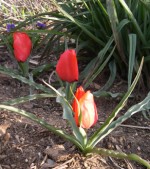
If you like tulips but not the big formal ones, this may be tulip you will love. It is late blooming and starts life in my garden with its narrow gray-green leaves with a wavy edge produced in a starfish-like formation. I was very taken by the foliage but then the flowers came and they were a knockout too. They are bright scarlet red with a dark black base and are borne on short stems. The effect is awesome!

These tulips are known as “species tulips” which means they are closer to “wild” tulips than the ones you usually see that are called hybrid tulips. They are smaller and naturalize better than the hybrid tulips and are excellent for rock gardens or planted in drifts. Tulipa batalinii is a member of the lily family, Liliaceae, that also includes fritillaria. The genus name, Tulipa, is the latinized version of the Turkish word for turban, Tulbend, referring to the resemblance of the flower to a turban. The specific epithet, batalinii, honors Jules Aime Battandier (1848-1922), French botanist, and an authority on Algerian plants.
Type: Bulb.
Bloom: Scarlet red with black base.
Size: 6” H.
Light: Full sun.
Soil: Well drained.
Fertilizer: Apply bulb fertilizer (7 10 5) three times per year: in the fall when you plant it for the root system; when the sprouts first poke through the soil for the foliage and flowers; and when the flower dies for the bulb itself.
Hardiness: Zones 3-8.
Care: Allow foliage to die naturally before removing.
Pests and Diseases: None of importance.
Propagation: Offsets of bulbs.
Companion plants: Grape hyacinths.
Other Outstanding Selections:
T. batalinii ‘Bright Gem’ has delicate sulfur yellow flushed with warm orange and broad, shiny foliage
T. batalinii ‘Apricot Jewel’ has deep apricot-orange with a bright golden yellow interior
T. batalinii ‘Bronze Charm’ has yellow flowers with bronze feathering.
